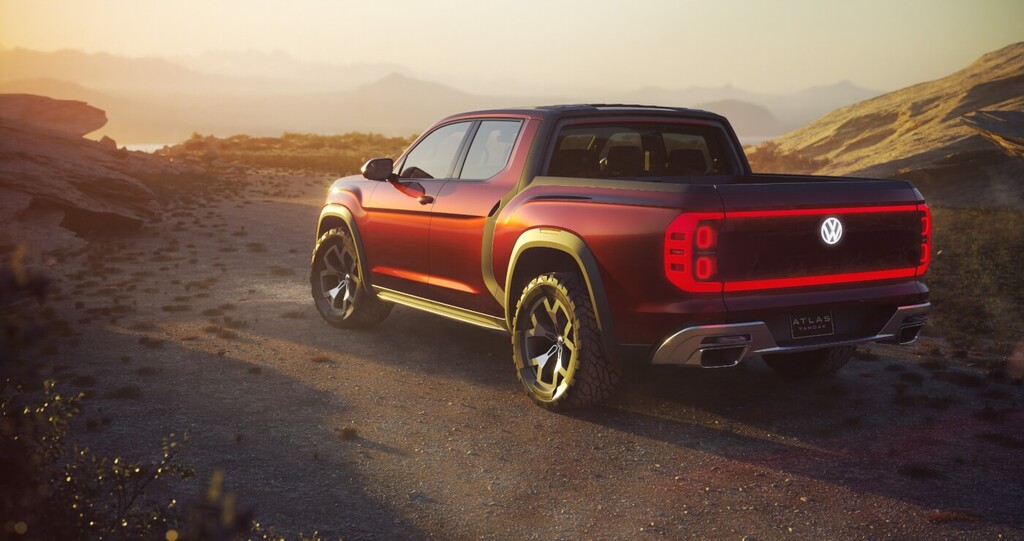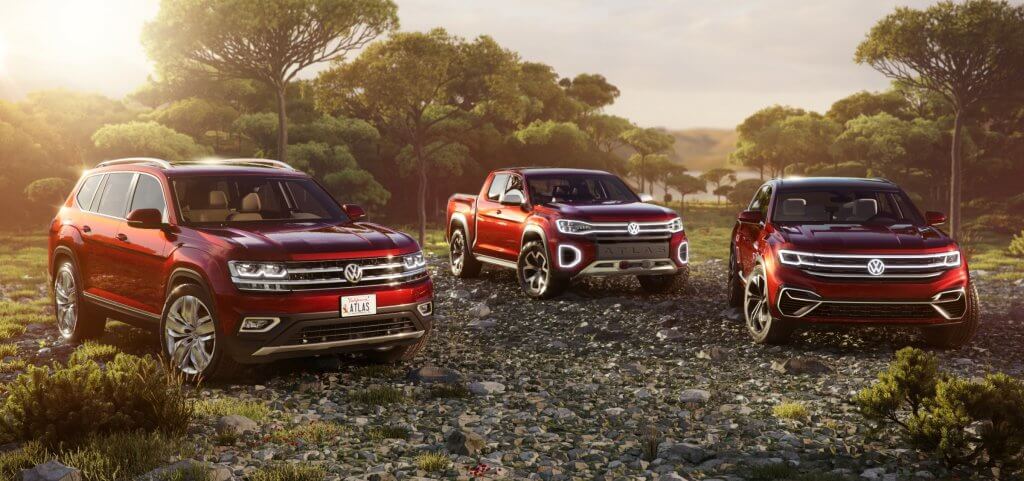 Chris Hamilton
.
August 18, 2018
.
Industry News
Chris Hamilton
.
August 18, 2018
.
Industry News

It’s no secret that the American market for pickup trucks is highly patriotic, one dominated by the Big Three of Ford, General Motors and Fiat-Chrysler (parent company of Dodge, Jeep and Ram).

That’s why it’s surprising to learn that Volkswagen is considering launching its own pickup truck for the US market, specifically a production version of the Atlas Tanoak concept.
Revealed last April at the New York Auto Show, the Tanoak is an Americanized version of VW’s Atlas SUV. While it carries the same 276hp 3.6L V6, the flatbed has a ruggedized frame, redesigned cockpit, a sturdier 8-speed automatic transmission and 4Motion AWD system.
At the time, the German automaker claimed to have no plans of putting the Tanoak into production. However, a recent interview with the company’s top executive for North America appeared to show that VW might not only produce the Tanoak, but make its first foray into the US pickup truck market.
In a recent report by Autocar, VW’s CEO for North America Hinrick Woebcken indicated the company was open to new designs that cater to American consumers. “It (the Tanoak) fits the brand well, because we want to get more American in the US.” However, Woebcken acknowledged that the US pickup market will be a tough nut to crack. “It’s something we have to look at very carefully. It’s a very patriotic segment, which American manufacturers dominate.”
There’s plenty of good reason for VW to join the midsize pickup segment. Thanks to a resurgent market, Ford is resurrecting the Ranger after a six-year hiatus, to compete with GM’s Chevrolet Colorado and GMC Canyon. Even foreign brands are getting in on the demand — apart from the Honda Ridgeline, Toyota Tacoma and Nissan Frontier, Americans will soon be getting the Hyundai Santa Cruz in a couple of years.
All of which puts the Tanoak in good company… if and when VW decides to join the party.
What historical context is provided for Volkswagen’s previous attempt at producing a pickup truck?
In the early 1980s, Volkswagen ventured into the pickup truck market with a model known globally as the Caddy. This compact pickup, based on the Rabbit vehicle platform, marked the company’s initial foray into this segment.
Despite its practical benefits and American manufacturing origins, the truck struggled to gain traction in the market. Sales dwindled within a few years, leading Volkswagen to discontinue the model. This brief but notable chapter in the company’s history provides insight into the challenges faced by even well-established brands when diversifying their vehicle range.
How do the key specifications of the Tanoak compare to the Honda Ridgeline?
When comparing the essential specifications of the Tanoak Prototype and the Ridgeline, several differences and similarities emerge across various metrics.
In summary, the Tanoak Prototype exhibits a longer wheelbase and overall dimensions, while the Ridgeline offers superior horsepower and acceleration. Both trucks present compelling features, with the Ridgeline’s established pricing adding to its appeal.
Has Volkswagen produced a pickup truck before, and what was its history?
Yes, Volkswagen has ventured into the pickup truck market before. During the early 1980s, they introduced a compact pickup known as the Caddy. This model was based on the Rabbit and was produced in Westmoreland, Pennsylvania.
Despite its origins in a blue-collar, coal-region setting and its impressive fuel efficiency, the Caddy didn’t achieve long-term commercial success. Sales dwindled after a few years, leading Volkswagen to discontinue the model. This brief gamble with the pickup truck market remained a unique chapter in the company’s diverse automotive history.
What are the key factors Volkswagen is considering to keep the Tanoak’s production costs down?
Volkswagen is focusing on several crucial strategies to minimize the production costs of the Tanoak.
By integrating these methods, Volkswagen aims to keep the costs manageable while maintaining quality and efficiency in production.
What minimum annual sales volume is necessary for Volkswagen to consider producing the Tanoak?
For Volkswagen to consider producing the Tanoak, there needs to be a commitment to an annual sales volume of at least 30,000 units. This threshold is typically required for the manufacturer to justify the production investment.
What unique feature does the Tanoak’s bed have?
The Tanoak’s bed stands out due to a distinctive, innovative feature. The side rail caps can be removed to reveal a sliding hoop mechanism. This hoop extends from the roof frame, offering an additional anchoring point ideal for securing items like surfboards or kayaks.
This unique setup makes it incredibly versatile for outdoor enthusiasts and those needing reliable cargo solutions.
What is Volkswagen’s predicted 0-60 time for the Tanoak, and how does it compare to other midsize trucks?
Volkswagen Volkswagen estimates the Tanoak will accelerate from 0 to 60 mph in 8.5 seconds. This acceleration rate places it among the slower vehicles within the midsize truck category.
How is Volkswagen gauging customer interest in the Tanoak?
Volkswagen is currently examining the feasibility of bringing the Tanoak to market. Their primary focus is on understanding potential customer interest and market dynamics.
To do this, they are considering several factors:
Volkswagen’s approach is methodical, ensuring they can make an informed decision based on comprehensive market research and customer insights.
What are the concerns regarding rear seat legroom in the Tanoak concept?
The primary concern with the Tanoak concept’s rear seats is the limited legroom. Passengers may find the back seat somewhat cramped, which raises questions about overall comfort for long journeys. Another point of contention is the thick design of the concept seats. While visually appealing, their bulkiness further reduces available space.
However, there’s a silver lining. The production version may feature thinner seats, which could add a few extra inches of crucial legroom, potentially resolving this issue.
How does the Tanoak drive in its current concept form?
The Tanoak concept offers a driving experience that leans more towards the rugged and adventurous side. During a short test drive along the scenic 17-Mile Drive, it was clear that the Tanoak showcases a brawnier aesthetic and feel compared to its cousin, the Atlas.
However, as a concept vehicle limited to a top speed of 20 mph, realistic evaluations of its VR6 powertrain performance were impossible. At such low speeds, even a cyclist managed to overtake us, making any true assessment of its acceleration moot.
Predictions suggest the Tanoak may achieve a 0-60 mph time of around 8.5 seconds, positioning it on the slower end of the midsize vehicle spectrum.
Overall, while the Tanoak exudes a sturdy and adventurous vibe, its current form leaves a lot of room for performance evaluation.
How does the design of the Tanoak’s bed differ from the Honda Ridgeline?
The Tanoak stands out with its distinctive approach to integrating the cabin and the bed. Instead of having a separate bed structure like the one found in some other models, the Tanoak combines the cabin and the bed into a single, seamless unit using conjoined sheet metal.
In summary, the Tanoak’s design approach creates a stronger, more visually appealing vehicle by integrating the bed and cabin into a single structure.
What is the starting price of the Honda Ridgeline, and how does it compare to the projected starting price of the Tanoak?
The Honda Ridgeline begins at just under $31,000, including destination charges. However, the price can quickly escalate to the mid-30s range, with some models exceeding $40,000. In contrast, if the Tanoak receives approval for production, the automaker aims to price it starting at or below $28,000. This makes the Tanoak a more cost-effective option when compared to the Ridgeline’s initial and higher-end prices.
What are the potential dimensions of the production version of the Tanoak compared to the concept?
Concept vehicles are often designed to impress, so they tend to be larger than their eventual production models. This principle suggests that while the Tanoak concept may boast significant dimensions, the production version is likely to be somewhat smaller.
To sum up, if the Tanoak concept is bigger in height, width, or length, expect the production model to trim down slightly in these areas. This sizing down helps align the vehicle with real-world usability and consumer expectations.
What were the sales figures for the first-generation Honda Ridgeline, and how did they change over time?
In its initial years, the first-generation Honda Ridgeline achieved notable success, peaking at 50,193 units sold in 2006. However, this momentum didn’t last long. The economic downturn significantly impacted the market, causing sales to plummet, eventually landing in the range of the teens. A positive turnaround occurred with the introduction of the new generation, which resulted in sales climbing back up to 34,749 units last year.
Share Link